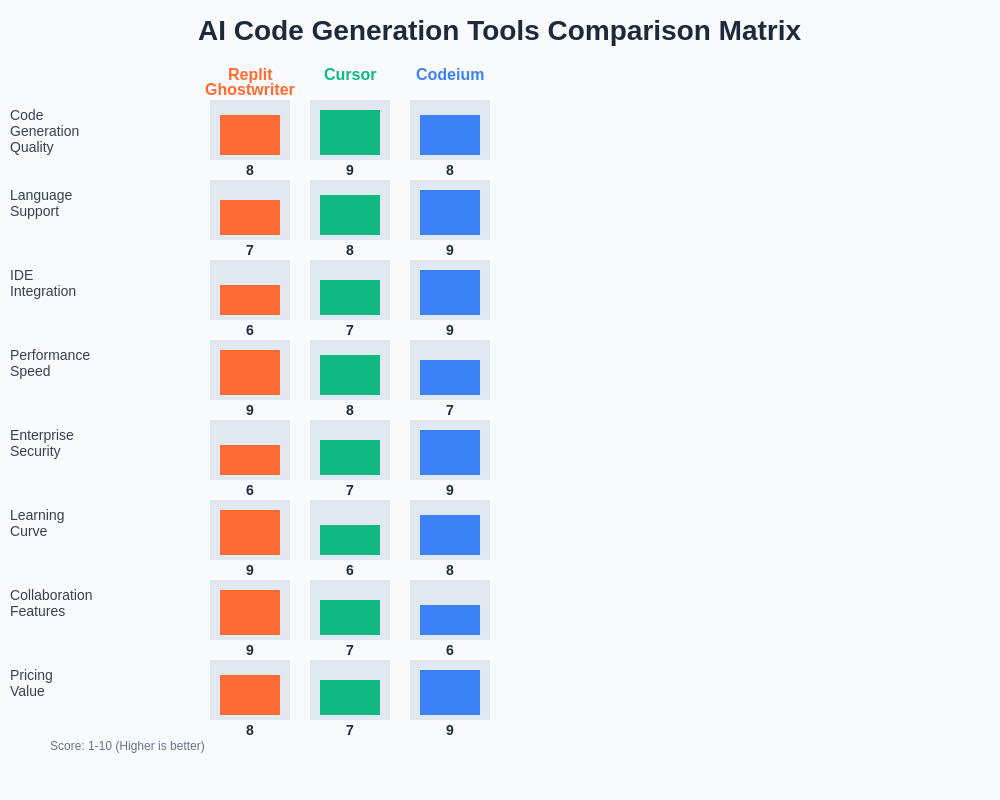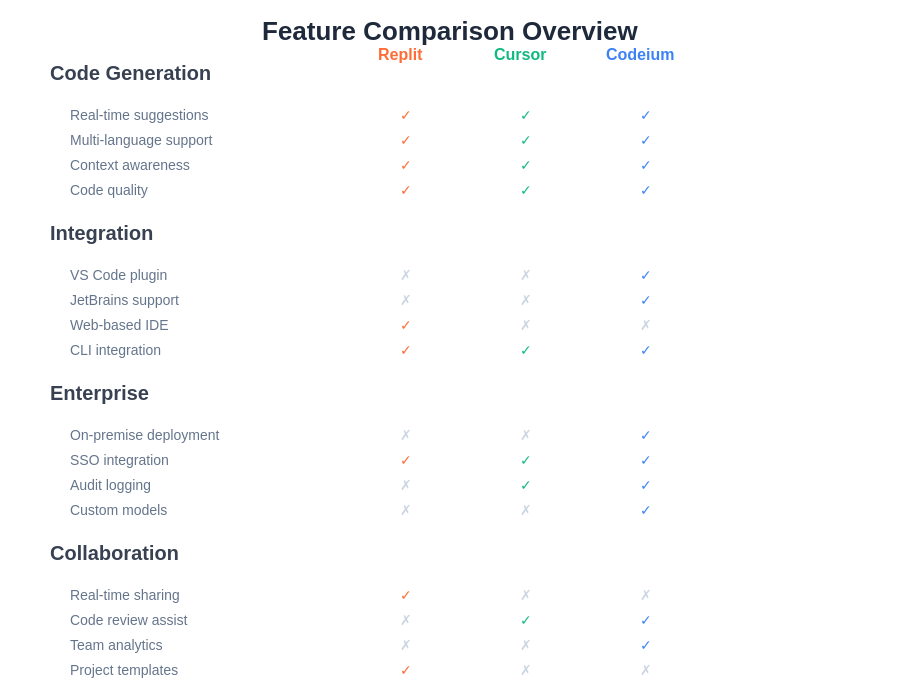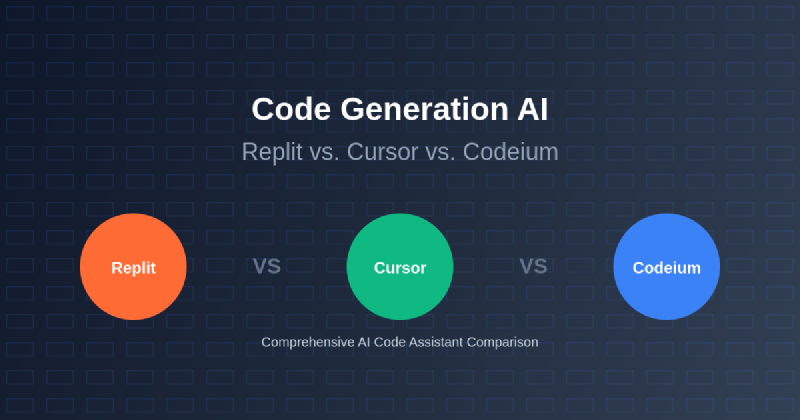The artificial intelligence revolution has fundamentally transformed the software development landscape, with code generation AI tools emerging as essential companions for modern developers. Among the most prominent players in this rapidly evolving ecosystem are Replit Ghostwriter, Cursor, and Codeium, each offering unique approaches to AI-powered coding assistance. These sophisticated platforms represent the cutting edge of machine learning applications in software development, promising to enhance productivity, reduce development time, and democratize programming expertise across skill levels.
Explore the latest AI development trends to understand how these tools fit into the broader context of artificial intelligence advancement in software engineering. The competition between these platforms has driven remarkable innovation, resulting in increasingly sophisticated features that blur the lines between human creativity and machine intelligence in code creation.
The Evolution of AI-Powered Code Generation
The journey from traditional integrated development environments to AI-enhanced coding platforms represents one of the most significant paradigm shifts in software engineering history. Early code completion tools offered simple syntax suggestions and basic autocomplete functionality, but modern AI code generators leverage large language models trained on vast repositories of high-quality code to provide contextually aware, semantically correct, and architecturally sound programming solutions.
This evolution has been particularly accelerated by advancements in transformer architecture and natural language processing, enabling these tools to understand not just syntax but the underlying intent and context of development tasks. The result is a new generation of coding assistants that can generate complete functions, implement complex algorithms, and even architect entire application components based on natural language descriptions or partial code implementations.
Replit Ghostwriter: Cloud-Native AI Development
Replit Ghostwriter distinguishes itself through its seamless integration with the Replit cloud development environment, offering a comprehensive AI-powered coding experience that spans from initial concept to deployed application. Built on advanced language models specifically fine-tuned for code generation, Ghostwriter provides real-time assistance that adapts to the developer’s coding style and project requirements.
The platform’s strength lies in its holistic approach to development assistance, combining code generation with intelligent debugging, optimization suggestions, and collaborative features that make it particularly valuable for educational environments and rapid prototyping scenarios. Ghostwriter’s deep integration with Replit’s infrastructure enables features like instant deployment, automatic dependency management, and seamless collaboration that traditional desktop-based AI tools struggle to match.
The tool excels in generating boilerplate code, implementing standard algorithms, and providing contextual suggestions that maintain consistency with existing codebases. Its ability to understand project structure and generate appropriate imports, function signatures, and class hierarchies makes it particularly effective for developers working on complex multi-file projects where maintaining architectural coherence is crucial.
Enhance your coding workflow with Claude’s advanced AI capabilities for complex reasoning and comprehensive development support that complements specialized code generation tools. The synergy between general-purpose AI assistants and specialized coding tools creates a powerful development ecosystem that addresses both creative problem-solving and technical implementation challenges.
Cursor: The AI-Native Code Editor Revolution
Cursor represents a fundamentally different approach to AI-assisted development by reimagining the code editor itself as an AI-native environment. Rather than adding AI features to existing editors, Cursor has been built from the ground up with artificial intelligence as a core architectural component, resulting in more seamless and intuitive interactions between developers and AI systems.
The editor’s innovative approach to AI integration manifests in features like natural language code editing, where developers can describe changes in plain English and watch as the AI implements the modifications with surgical precision. This capability extends beyond simple code generation to include complex refactoring operations, architectural changes, and even bug fixes that require understanding of intricate code relationships and dependencies.
Cursor’s AI model demonstrates remarkable proficiency in understanding context across entire projects, enabling it to make intelligent suggestions that consider not just the immediate code being written but the broader architectural patterns and conventions used throughout the codebase. This holistic understanding results in generated code that feels naturally integrated rather than artificially inserted, maintaining the stylistic and structural consistency that is crucial for long-term code maintainability.
The platform’s approach to AI-human collaboration is particularly noteworthy, offering multiple interaction modes that cater to different development styles and preferences. Whether developers prefer traditional autocomplete-style assistance, conversational code generation, or proactive AI suggestions, Cursor adapts to their workflow rather than forcing them to adapt to the tool.
Codeium: Enterprise-Grade AI Code Intelligence
Codeium has carved out a distinctive position in the AI code generation market by focusing on enterprise-grade features, security considerations, and comprehensive language support that makes it suitable for large-scale development organizations with diverse technology stacks. The platform’s architecture prioritizes privacy and security, addressing concerns that often prevent enterprise adoption of AI-powered development tools.
The tool’s strength lies in its extensive language support, covering over 70 programming languages with varying degrees of sophistication, making it one of the most versatile AI coding assistants available. This broad compatibility extends to integration with popular development environments, supporting Visual Studio Code, JetBrains IDEs, Vim, Emacs, and numerous other editors through well-designed plugins and extensions.
Codeium’s AI models demonstrate particular excellence in understanding complex codebases, legacy systems, and enterprise-specific patterns that are often challenging for AI systems to navigate. The platform’s ability to learn from organizational coding patterns and adapt to specific enterprise requirements makes it particularly valuable for large development teams working on established codebases with decades of accumulated complexity.
The platform’s approach to code generation emphasizes accuracy and reliability over speed, resulting in suggestions that require less manual review and correction. This focus on quality over quantity makes Codeium particularly suitable for production environments where code quality and reliability are paramount concerns.

The comparative analysis of these three platforms reveals distinct strengths and target audiences, with each tool excelling in different aspects of the development workflow. Understanding these differences is crucial for developers and organizations seeking to optimize their AI-assisted development processes.
Performance and Accuracy Analysis
The performance characteristics of AI code generation tools can be evaluated across multiple dimensions, including suggestion latency, contextual accuracy, code quality, and integration smoothness. Replit Ghostwriter benefits from its cloud-native architecture, providing consistently fast response times and seamless updates to underlying models without requiring local installations or updates.
Cursor’s performance is particularly impressive in scenarios requiring complex refactoring or architectural changes, where its deep integration with the editing environment enables more sophisticated analysis and modification capabilities. The tool’s ability to understand and maintain context across multiple files and complex code relationships results in more accurate and useful suggestions for large-scale development tasks.
Codeium’s performance characteristics are optimized for enterprise environments, with robust caching mechanisms, offline capabilities, and efficient resource utilization that make it suitable for deployment in resource-constrained or security-sensitive environments. The platform’s focus on accuracy over speed results in slightly longer response times but higher-quality suggestions that require less manual correction.
Integration Ecosystem and Workflow Compatibility
The effectiveness of AI code generation tools is largely determined by how seamlessly they integrate into existing development workflows and toolchains. Replit Ghostwriter’s tight integration with the Replit ecosystem provides unparalleled coherence for developers working entirely within that environment, but may present challenges for teams using diverse development tools and deployment pipelines.
Cursor’s approach to workflow integration represents a more radical departure from traditional development patterns, requiring developers to adopt a new editor and potentially modify established workflows. However, this investment often pays dividends through more sophisticated AI interactions and capabilities that are difficult to achieve through plugin-based approaches.
Codeium’s plugin-based architecture offers the greatest flexibility for integration into existing development environments, supporting a wide range of editors and IDEs without requiring significant workflow changes. This compatibility makes it particularly attractive for organizations with established development processes and tool preferences.
Discover comprehensive AI research capabilities with Perplexity to stay informed about the latest developments in AI code generation and make informed decisions about tool adoption and integration strategies.
Security and Privacy Considerations
The security and privacy implications of AI code generation tools represent critical considerations for enterprise adoption, particularly in industries with strict compliance requirements or sensitive intellectual property concerns. Each platform approaches these challenges differently, with varying levels of data protection, on-premises deployment options, and compliance certifications.
Replit Ghostwriter operates within Replit’s cloud infrastructure, which provides robust security measures but requires organizations to trust third-party cloud providers with their code and data. The platform offers various privacy controls and enterprise features designed to address these concerns, but organizations with strict data sovereignty requirements may find cloud-based solutions challenging to adopt.
Cursor provides more flexibility in deployment options, including local processing capabilities that can address some privacy concerns while maintaining advanced AI functionality. The platform’s architecture allows for various configurations that balance AI capability with security requirements, making it suitable for organizations with moderate security concerns.
Codeium has made enterprise security a primary focus, offering on-premises deployment options, advanced encryption, audit logging, and compliance certifications that meet the requirements of highly regulated industries. The platform’s security-first approach may result in some limitations on AI capabilities but provides the confidence necessary for enterprise adoption in sensitive environments.
Language Support and Specialization
The breadth and depth of programming language support vary significantly across these platforms, with each tool demonstrating particular strengths in different language ecosystems and development paradigms. Understanding these specializations is crucial for developers working in specific technology stacks or with particular language requirements.
Replit Ghostwriter excels in languages and frameworks commonly used in educational environments and rapid prototyping scenarios, including Python, JavaScript, Java, and popular web development frameworks. The tool’s suggestions are particularly well-suited for beginners and intermediate developers, providing clear, well-commented code that serves educational purposes while remaining functionally correct.
Cursor demonstrates exceptional capability across a wide range of languages, with particularly strong performance in modern languages like TypeScript, Rust, and Go, as well as traditional enterprise languages like Java and C#. The tool’s deep understanding of language-specific idioms and best practices makes it valuable for experienced developers working on sophisticated applications.
Codeium’s comprehensive language support encompasses both modern and legacy languages, including specialized domains like embedded systems programming, scientific computing, and database query languages. This broad compatibility makes it particularly valuable for organizations maintaining diverse codebases spanning multiple generations of technology.

The comprehensive analysis reveals the distinct strengths and positioning of each platform across critical evaluation dimensions. Understanding these performance characteristics enables informed decision-making based on specific development requirements and organizational priorities.
Cost-Effectiveness and Value Proposition
The economic considerations surrounding AI code generation tools extend beyond simple subscription costs to include factors like productivity improvements, learning curve investments, and long-term maintenance requirements. Each platform offers different pricing models and value propositions that appeal to different types of users and organizations.
Replit Ghostwriter’s pricing is integrated with Replit’s overall platform offerings, providing good value for developers already committed to the Replit ecosystem but potentially representing additional costs for those using external development environments. The tool’s educational pricing and free tier options make it particularly attractive for students and hobbyist developers.
Cursor’s pricing model reflects its position as a premium development tool, with costs that may be justified by significant productivity improvements for experienced developers working on complex projects. The platform’s focus on advanced features and sophisticated AI capabilities makes it most suitable for developers and organizations where development productivity directly impacts business outcomes.
Codeium offers various pricing tiers designed to accommodate different organizational sizes and requirements, with enterprise features that can provide substantial value for large development teams. The platform’s free tier provides significant functionality for individual developers and small teams, making it accessible for organizations with limited budgets.

The detailed feature analysis demonstrates how each platform addresses different aspects of the development workflow, from basic code generation to advanced enterprise integration capabilities. This comprehensive view helps organizations align tool selection with their specific technical and operational requirements.
Real-World Performance Scenarios
Practical evaluation of these AI code generation tools requires examination of their performance in realistic development scenarios that reflect the complexity and constraints of actual software projects. Different tools excel in different types of development tasks, making scenario-based evaluation crucial for informed decision-making.
In rapid prototyping scenarios, Replit Ghostwriter’s integration with instant deployment and collaboration features provides significant advantages, enabling developers to quickly iterate on ideas and share functional prototypes with stakeholders. The tool’s ability to generate complete application scaffolds and integrate with popular APIs makes it particularly effective for hackathons and proof-of-concept development.
For large-scale application development, Cursor’s sophisticated understanding of code architecture and relationships provides substantial value in maintaining consistency and quality across complex codebases. The tool’s ability to suggest architectural improvements and refactor code while maintaining functionality makes it particularly valuable for teams working on established applications with significant technical debt.
Enterprise development scenarios often favor Codeium’s reliability and security features, particularly in environments where code quality and compliance are paramount. The tool’s ability to learn from organizational coding standards and enforce consistency across development teams makes it valuable for maintaining code quality at scale.
Integration with Development Workflows
The success of AI code generation tools depends heavily on their ability to integrate seamlessly with existing development workflows, version control systems, testing frameworks, and deployment pipelines. Each platform approaches workflow integration differently, with varying levels of compatibility and flexibility.
Replit Ghostwriter’s cloud-native approach provides excellent integration with cloud-based development workflows, particularly those involving continuous integration and deployment pipelines. The platform’s ability to work with version control systems and collaborative development processes makes it suitable for distributed teams working on cloud-native applications.
Cursor’s deep integration with the development environment enables more sophisticated workflow automation, including intelligent code review assistance, automated testing suggestions, and deployment optimization recommendations. The platform’s ability to understand entire project contexts makes it valuable for complex workflows involving multiple services and dependencies.
Codeium’s plugin-based architecture provides the greatest flexibility for integration with established development workflows, supporting custom configurations and integrations that can be tailored to specific organizational requirements. This adaptability makes it suitable for organizations with complex or legacy development processes that cannot easily accommodate new tools.
Learning Curve and Developer Adoption
The adoption challenges associated with AI code generation tools vary significantly based on their complexity, integration requirements, and departure from traditional development patterns. Understanding these adoption challenges is crucial for organizations planning tool rollouts and training programs.
Replit Ghostwriter benefits from its integration with an already user-friendly development environment, making it relatively easy for developers to adopt without significant changes to their existing workflows. The tool’s educational focus and comprehensive documentation make it particularly suitable for developers new to AI-assisted coding.
Cursor represents a more significant adoption challenge due to its requirement for developers to switch editors and potentially modify established workflows. However, the platform’s sophisticated features and capabilities often justify the investment in learning and adaptation, particularly for experienced developers working on complex projects.
Codeium’s plugin-based approach minimizes adoption challenges by allowing developers to integrate AI assistance into their existing development environments without significant workflow changes. This compatibility makes it particularly attractive for organizations with established development processes and tool preferences.
Future Development and Innovation Trajectories
The rapid evolution of AI code generation tools suggests continued innovation and capability improvements that will further transform software development practices. Understanding the development trajectories of these platforms provides insight into their long-term viability and strategic value for development organizations.
Replit Ghostwriter’s development appears focused on expanding its integration with cloud development workflows and improving its educational applications. The platform’s emphasis on collaboration and accessibility suggests continued innovation in areas like real-time collaborative coding and AI-assisted learning environments.
Cursor’s innovation trajectory emphasizes the deepening integration of AI into the development experience, with potential developments in areas like automated testing, intelligent code review, and predictive development assistance. The platform’s focus on reimagining the development environment suggests continued innovation in human-AI collaboration patterns.
Codeium’s development priorities appear focused on enterprise features, security enhancements, and expanded language support. The platform’s emphasis on reliability and compatibility suggests continued innovation in areas like compliance automation, security scanning, and enterprise workflow integration.
Strategic Considerations for Tool Selection
Choosing between these AI code generation tools requires careful consideration of organizational requirements, development workflows, security constraints, and long-term strategic objectives. The decision framework should incorporate both immediate productivity benefits and long-term implications for development practices and team capabilities.
Organizations prioritizing rapid prototyping and educational applications may find Replit Ghostwriter’s integrated approach and collaborative features most valuable, particularly if they are already committed to cloud-based development workflows. The platform’s accessibility and ease of use make it particularly suitable for teams with varying skill levels and educational requirements.
Development teams focused on sophisticated applications and willing to invest in advanced tooling may find Cursor’s AI-native approach provides the greatest long-term value, despite requiring more significant adoption investments. The platform’s advanced capabilities and innovative features make it particularly suitable for experienced developers working on complex, high-value applications.
Enterprise organizations with established development processes and strict security requirements may find Codeium’s reliability, security features, and compatibility most valuable, even if it requires sacrificing some advanced capabilities. The platform’s enterprise focus and comprehensive support make it suitable for large-scale development organizations with complex requirements.
The landscape of AI code generation continues to evolve rapidly, with each platform pursuing distinct strategies for capturing developer mindshare and addressing the diverse needs of the software development community. The choice between these tools ultimately depends on specific requirements, constraints, and strategic objectives that vary significantly across different development contexts and organizational priorities.
Disclaimer
This article is for informational purposes only and does not constitute professional advice. The views expressed are based on current understanding of AI code generation tools and their capabilities. Tool features, pricing, and availability may change over time. Readers should conduct their own research and testing to determine which tools best meet their specific requirements. The effectiveness of AI code generation tools may vary depending on use cases, programming languages, and individual development practices.
